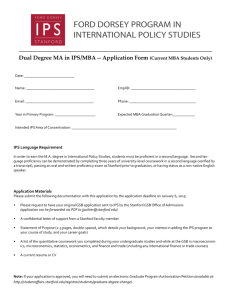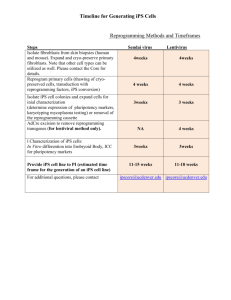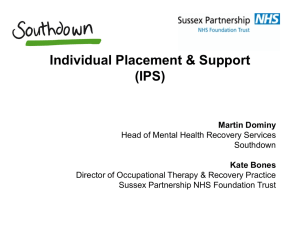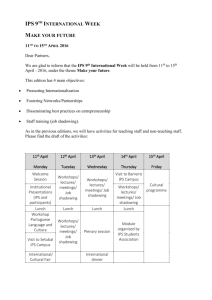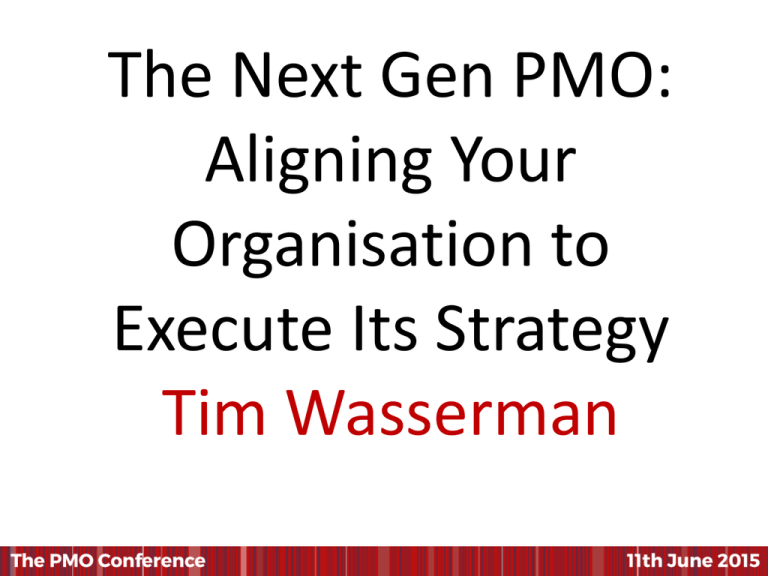
The Next Gen PMO:
Aligning Your
Organisation to
Execute Its Strategy
Tim Wasserman
The Next Gen PMO:
Aligning Your
Organization
to
Execute Its Strategy
Tim Wasserman
Programme Director, Stanford Advanced
Project Management
Chief Learning Officer, ESI International &
IPS Learning
Objectives for Today
Share framework for improving
strategic alignment of project-based
work
Explore organizational, leadership and
individual dynamics that enable
improved performance
Provide actionable, applicable tools
© 2015, IPS Learning/ESI International. All rights reserved.
Why Good Strategies Fail
…lessons for the C-suite
Only 56% of strategic
initiatives have been
successful
9% rate themselves as
excellent on successful
execution
61% of firms often struggle to
bridge strategy-execution gap
The Economist Intelligence Unit, March 2013
© 2015, IPS Learning/ESI International. All rights reserved.
Global CEO’s #1 Strategy
Seek better alignment
between strategy, objectives
and organizational
capabilities
The Conference Board, 2014
© 2015, IPS Learning/ESI International. All rights reserved.
Why focus on Alignment?
PMI’s Pulse of the Profession, February 2014
© 2015, IPS Learning/ESI International. All rights reserved.
Why do we get less than
desirable performance?
© 2015, IPS Learning/ESI International. All rights reserved.
Why Good Strategies Fail
Alignment between strategy
and execution unclear
Failure to accurately predict
results in scope creep
Impact of organizational
dynamics are
misunderstood or ignored
Risks not well understood
Lack of aligned performance
metrics
Required skill sets don’t
match required needs
Programs/projects
extremely complex
Inconsistent processes on
how to manage projects and
programs
Lack of clear agreements
around interfaces and
interdependencies
© 2015, IPS Learning/ESI International. All rights reserved.
Lack of resources, people
spread too thin
Other organizational
functions and members not
on board
Difficult to manage without
authority over people who
are on multiple projects, not
functional reports
Bridging the gap…
© 2015, IPS Learning/ESI International. All rights reserved.
9
Our Strategic Execution
Journey
© 2015, IPS Learning/ESI International. All rights reserved.
The Strategic Execution Framework
Who are you?
What is the context?
Where are you going?
What needs creating?
How will we build it?
How will you operate?
© 2015, Stanford Advanced Project Management & IPS Learning. All rights reserved.
Unpacking the SEF
Strategy Making
Strategy Execution
© 2015, Stanford Advanced Project Management & IPS Learning. All rights reserved.
What’s Your External
Environment?
Energy
•
•
•
Price of crude oil
Global competition
Energy consumption
Financial Services
• Hyper competitive market
• New emerging technologies
• Faster time to market
© 2015, Stanford Advanced Project Management & IPS Learning. All rights reserved.
What’s your Context?
Organization
Program/project
Team
Individual
© 2015, IPS Learning/ESI International. All rights reserved.
Questions to Ask &
Actions to Consider
How aware are team members of the
current organizational context?
How often is this discussed?
How much is enough information?
Who helps you decide what to share?
© 2015, IPS Learning/ESI International. All rights reserved.
The Ideation domain
The reason the
organization exists
Character, image,
brand, and values
© 2015, IPS Learning/ESI International. All rights reserved.
What the organization is
dedicated to in the long term
Xerox’s Ideation, 1981
“Xerox perceived itself as only in the
office copier business.”
Malcolm Gladwell
© 2015, IPS Learning/ESI International. All rights reserved.
© 2015, IPS Learning/ESI International. All rights reserved.
Questions to Ask & Actions to Consider
• What is your PMO’s Ideation?
• Is it compelling to the point of being a
“magnet?”
• How is your PMO perceived by it’s
customers? By senior management? By
the project and program community?
• Can your people connect what they are
doing to the organization’s Ideation?
© 2015, IPS Learning/ESI International. All rights reserved.
Retaining Top PMO Talent When You Have No Authority
The Nature domain
The artifacts, core values, and
behaviors of the organization
How an organization
designs relationships
between areas or functions
© 2015, IPS Learning/ESI International. All rights reserved.
The path an organization designs
to achieve its purpose and goals
Misaligned Ideation, Culture and
Strategy
© 2015, IPS Learning/ESI International. All rights reserved.
Ideation
Facebook’s mission is to give people
the power to share and make the world
more open and connected.
© 2015, IPS Learning/ESI International. All rights reserved.
Bootcamp
© 2015, IPS Learning/ESI International. All rights reserved.
Four core cultures
Every organization has a predominant culture
and may have subordinate cultures.
Collaboration
Control
Collaboration
Cultivation
Cultivation
Control
Competence
Competence
Source: Schneider, William E. The Reengineering Alternative: A Plan for Making Your Current Culture Work. Burr Ridge,
IL: Irwin Professional Pub., 1994.
© 2015, IPS Learning/ESI International. All rights reserved.
Culture and Today’s Work
Approaches
Collaboration
Collaboration
Cultivation
© 2015, Stanford Advanced Project Management & IPS Learning. All rights reserved.
Control
Control
Competence
Aligning PMO Structure and Culture
Collaboration
Control
(affiliation)
(order & security)
Collaboration
Enterprise/Org Unit
PMO
Control
Project Support
PMO
Project-Specific
PMO
CoE
PMO
Competence
Cultivation
(self-actualization)
Cultivation (achievement)
Competence
© 2015, IPS Learning/ESI International. All rights reserved.
Retaining Top PMO Talent When You Have No Authority
Your Culture Maps
Draw a culture
map for:
Collaboration
Control
5
4
5
3
Your Organization
(red)
Your PMO
(green)
4
2
3
1
2
1
1
2
1
2
3
3
4
5
4
5
Cultivation
© 2014 IPS Learning LLC and contributors
© 2015, IPS Learning/ESI International. All rights reserved.
Competence
What structure is appropriate?
© 2015, IPS Learning/ESI International. All rights reserved.
Questions to Ask & Actions to Consider
What is your PMO’s culture “egg”?
Are you culture and structure aligned
within the PMO?
How does this compare/align to your
business unit? The overall organization?
What do you need to adjust?
© 2015, IPS Learning/ESI International. All rights reserved.
Retaining Top PMO Talent When You Have No Authority
The Vision domain
The determination of
specific desired results
The path an organization
designs to achieve its
purpose and goals
© 2015, IPS Learning/ESI International. All rights reserved.
The vehicle to evaluate
progress to the achievement
of strategic goals
Clear Strategic Vision: SW Airlines
Source: Porter, Michael. "What is Strategy?" Harvard Business Review HBR OnPoint
Enhanced Edition, Product Number: 4134 (February 1, 2000).
© 2015, IPS Learning/ESI International. All rights reserved.
How do they get there?
© 2015, IPS Learning/ESI International. All rights reserved.
Questions to Ask & Actions to Consider
Are your required reporting metrics
meaningful, aligned and adding value to the
organization?
Do project/program metrics link to the
strategic goals?
Do your team members know what these
metrics are?
To what extent can they impact these?
Are individual and team metrics aligned?
© 2015, IPS Learning/ESI International. All rights reserved.
Retaining Top PMO Talent When You Have No Authority
The Engagement domain
The path an organization designs to
achieve its purpose and goals
Strategy based, prioritized set of projects and programs,
reconciled to the resources required to accomplish them
© 2015, IPS Learning/ESI International. All rights reserved.
An organization's real strategy is the
portfolio of strategic projects in which it
invests
Real
strategy
© 2015, IPS Learning/ESI International. All rights reserved.
Official
strategy
Strategic goals & portfolio are
both moving targets
Strategic
Portfolio!
© 2015, IPS Learning/ESI International. All rights reserved.
Strategic
Goals
Questions to Ask & Actions to Consider
Can you map the portfolio of project
investments with the organization
strategies?
How aligned is the portfolio process with the
espoused ideation and culture of the
organization?
Are portfolio criteria understood and agreed
upon at all levels of the organization?
How effective are those responsible for
providing portfolio inputs at influencing the
portfolio?
© 2015, IPS Learning/ESI International. All rights reserved.
Retaining Top PMO Talent When You Have No Authority
The Synthesis domain
Strategy-based, prioritized set of projects and
programs, reconciled to the resources
required to accomplish them
Multiple interdependent projects
managed as a single unit
© 2015, IPS Learning/ESI International. All rights reserved.
Unique, temporary efforts
defined by deliverables,
schedule, and resources
Critical Skills, Tools and Insights
© 2015, IPS Learning/ESI International. All rights reserved.
Predictability vs. Uncertainty:
Complex Program Attributes
Predictable
Uncertain
Authority
Centralized
Decentralized
Process
Plan-Execute-Track-Control
Iterate through Try-Fail-Learn
Reward System
“Failure” to achieve goals is
punished
Learning through small partial “failures” is
rewarded
Information
Flow
Partition information and share it
top-down on “need to know” basis
Create many-to-many communication
Locus of
Big Picture
Global awareness exists only at top
via status reports
Global awareness exists around edges of
the organization
How Program
Clearly specify project outputs Manager Leads “Tell What to Do”
Clarify ideation and desired strategic
outcomes - “Teach How to Decide”
Management
Style
Adaptive, collaborative
Top-down command & control
© 2015, IPS Learning/ESI International. All rights reserved.
Questions to Ask & Actions to Consider
What is the PMO’s role and/or charter in
driving project and program execution?
How is this communicated to and
understood by the organization?
Are the PMOs offerings/services aligned?
© 2015, IPS Learning/ESI International. All rights reserved.
Retaining Top PMO Talent When You Have No Authority
The Transition domain
Multiple interdependent
projects managed as a
single unit
Unique, temporary efforts
defined by deliverables,
schedule, and resources
The ongoing processes of the
enterprise that deliver value
to the customer
© 2015, IPS Learning/ESI International. All rights reserved.
What barriers do you see to
successful transition?
Resistance to change
Lack of acceptance/not invented here
End user success criteria/metrics not
aligned with developer metrics
© 2015, IPS Learning/ESI International. All rights reserved.
Rapid Transformation
30-90 Days
Pre-Transformation
30 Days
Phase 1:
Diagnosis
30 Days
Phase 2:
Envisioning
the Future
30 Days
Phase 3:
Paving the
Road
6-12 Months
Transformation
Implementation
Carlos Ghosn: Renault-Nissan
© 2015, IPS Learning/ESI International. All rights reserved.
Questions to Ask &
Actions to Consider
When do you involve those who own the
Operations experience?
How do you integrate them early and
often?
Are your operational success metrics
aligned with project metrics?
When does work begin on addressing the
organizational change component?
© 2015, IPS Learning/ESI International. All rights reserved.
Imperatives of Strategic Execution
I
N
V
© 2015, IPS Learning/ESI International. All rights reserved.
E
S
T
Imperatives of Strategic Execution
I deation
N ature
Know who you are, why you exist and where you
are going
Align your strategy, structure and culture
Continually rearticulate and quantify your desired
outcomes
Vision
Continually reinvest in the right portfolio of strategic
Engagement projects to achieve current strategic outcomes
your strategic projects balancing appropriate
Synthesis Execute
levels of PM 1.0 (discipline) vs. PM 2.0 (agility)
Transition your projects’ benefits into operations, and
ransition
T
reinvest the project resources
© 2015, IPS Learning/ESI International. All rights reserved.
SEF and Meta Alignment
Alignment between
and within the domains
enables strategic
execution
Challenges to strategic
execution are a
reflection of
misalignment
© 2015, IPS Learning/ESI International. All rights reserved.
Where are your
Strengths and
Opportunities?
© 2015, IPS Learning/ESI International. All rights reserved.
What Works Well
Opportunities for
Improvement
© 2015, Stanford Advanced Project Management & IPS Learning. All rights reserved.
Engaging and Aligning Your People
© 2015, IPS Learning/ESI International. All rights reserved.
Critical PBW Leadership Competencies
for Execution Excellence
© 2015, IPS Learning/ESI International. All rights reserved.
Some parting thoughts…
1. It’s all about ALIGNMENT
2. Do the RIGHT PROJECTS and
do the PROJECTS RIGHT
3. Leading project-based work
requires DISCIPLINE and
AGILITY
© 2015, IPS Learning/ESI International. All rights reserved.
Questions
and
Additional
Discussion
© 2015, IPS Learning/ESI International. All rights reserved.


